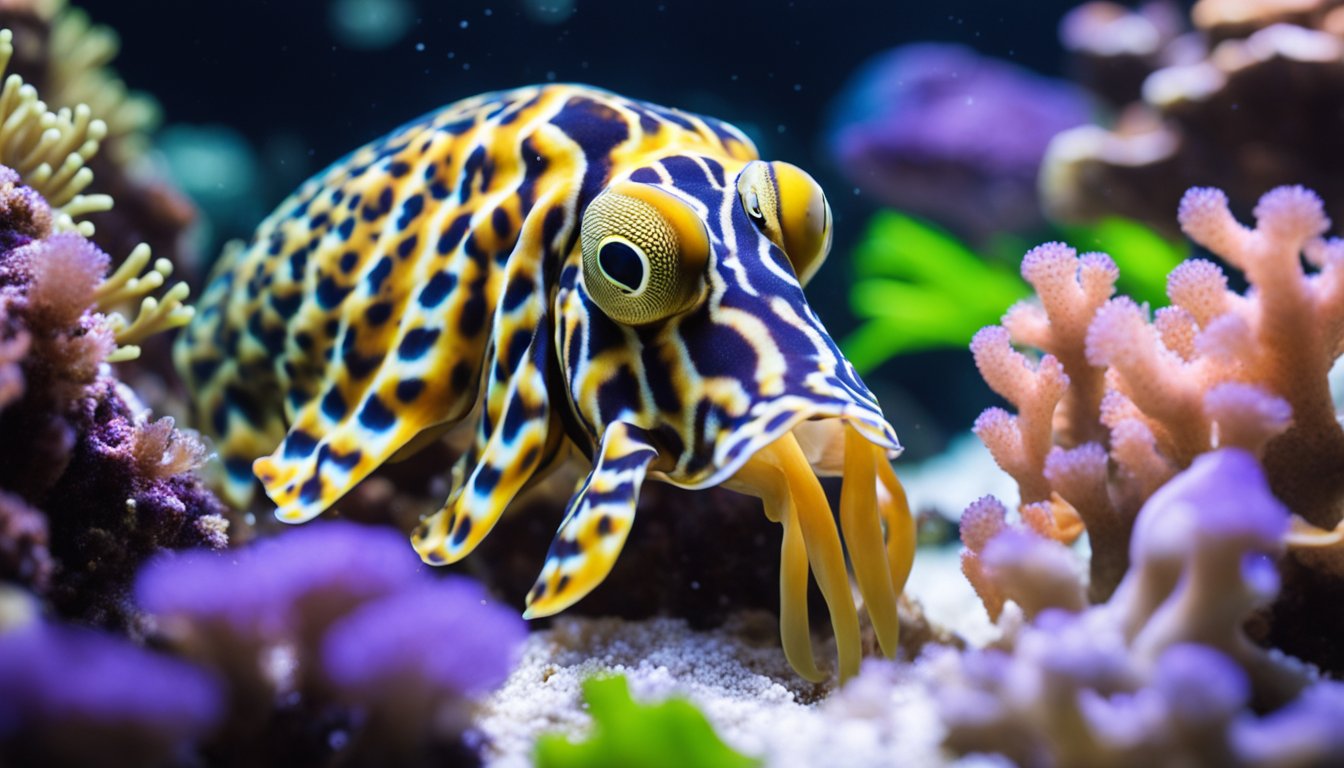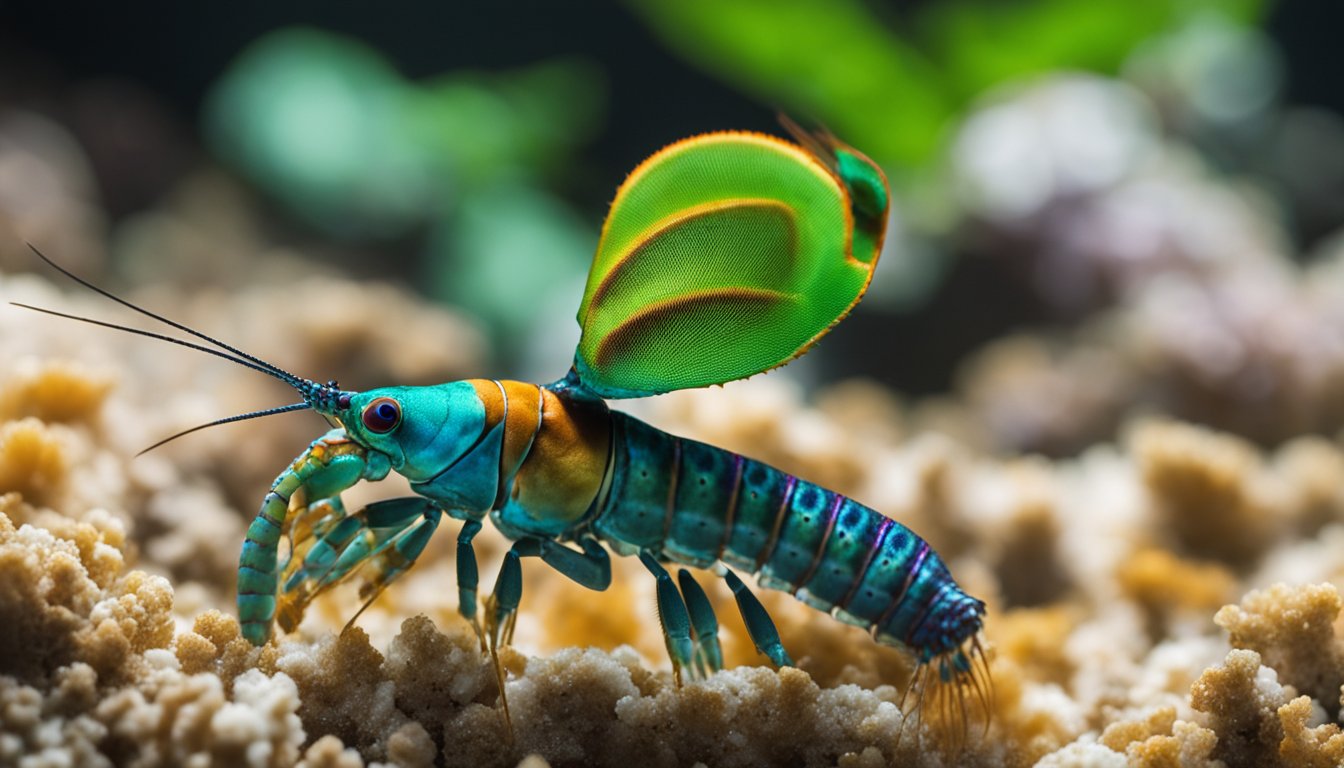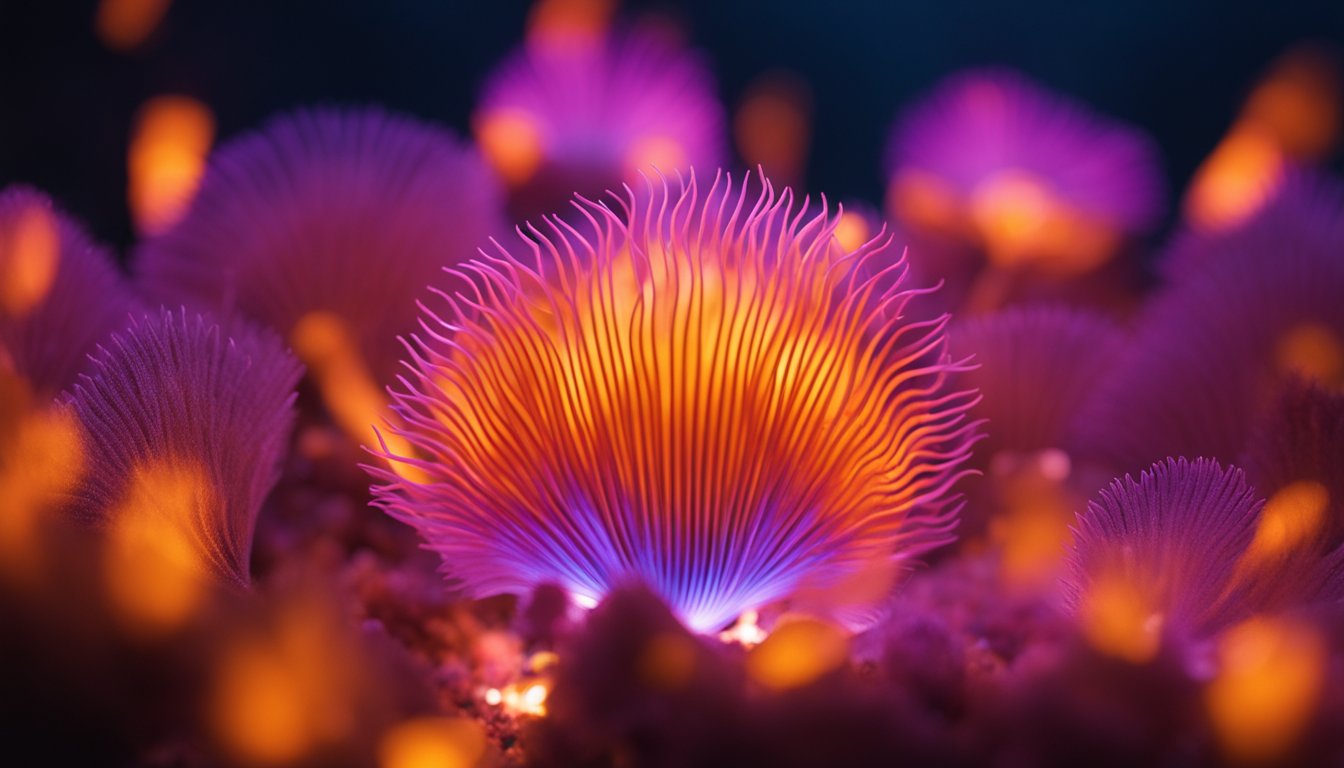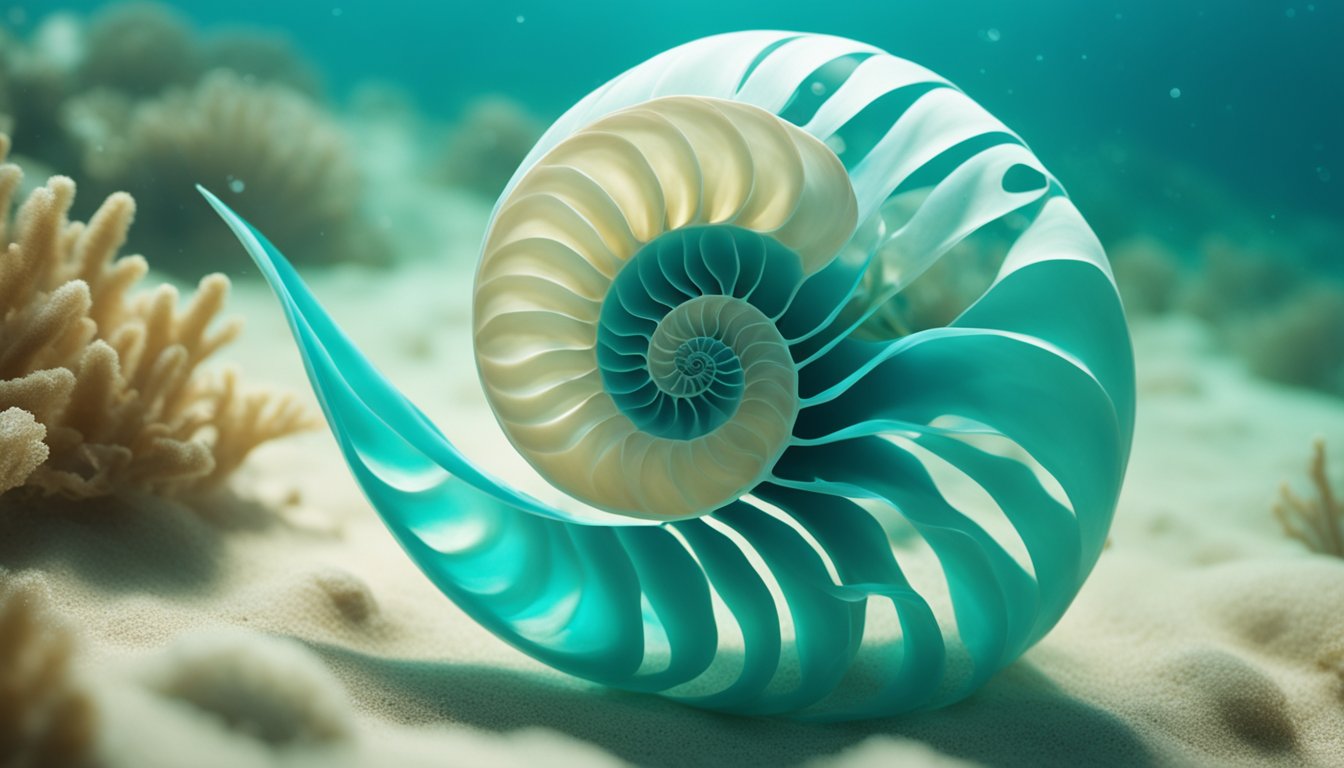Imagine you’re looking through a rainbow kaleidoscope and suddenly, the colors shift and dance before your eyes.
That’s a bit what it’s like to watch the common cuttlefish in its natural habitat!
These remarkable creatures have an extraordinary ability to change their skin color and pattern.
It’s not just for show; they use this talent to communicate, hide from predators, and even hypnotize their prey before they snap them up for a tasty snack.
We’re about to dive into the world of these amazing cephalopods and discover how they perform their colorful magic tricks.

Cuttlefish belong to a group of mollusks called cephalopods, which also includes their cousins the octopus and squid.
But cuttlefish are the true artists of this family when it comes to color change.
They have special skin cells called chromatophores that expand and contract to reveal different hues.
Beneath these are layers of reflecting cells that can shine like little mirrors, adding even more pizzazz to their displays.
By controlling all these elements, they can go from camouflaged to flashy in the blink of an eye!
Have you ever tried to send a secret message to a friend without talking? Cuttlefish are masters of this!
They can send signals to one another by changing the pattern on their skin.
Some scientists even think that these patterns could represent cuttlefish emotions or intentions—a sort of underwater body language.
Every time we watch these intelligent animals, we discover more about their colorful world and how they interact with it.
It really makes us wonder what it would be like if we could change colors to express ourselves, doesn’t it?
Mysterious Masters of Disguise

We’re about to uncover the secrets of the common cuttlefish, remarkable creatures renowned for their astonishing ability to change their color and pattern.
This talent helps them communicate and stay hidden from predators or prey.
Colorful Communication
Imagine talking to your friends just by changing the color of your skin—that’s what cuttlefish do!
These amazing animals can swiftly alter their skin color to display an array of dazzling patterns.
This isn’t just for show; it’s their way of chatting with one another.
They may flash a zebra-like pattern during a face-off or show off hypnotic, pulsating displays to woo a potential mate.
Scientists believe these visual signals are a crucial part of cuttlefish social life.
Hunting and Hiding
When it’s time to eat, cuttlefish use their color-changing superpower to become nearly invisible.
They blend into their surroundings, creating a perfect camouflage that fools even the sharpest-eyed prey.
Stealth is key for these hunters, and by mimicking the texture of rocks or the sandiness of the ocean floor, they set the perfect trap.
And when the threat of a predator looms, they can transform again, mixing into the sea’s canvas, making themselves hard to spot.
Isn’t it fascinating how their natural cloaks serve both as a shield and a weapon?
Beneath the Surface: Anatomy of the Cuttlefish

Let’s dive in and discover the fantastic features hidden beneath the waves in the common cuttlefish.
We’ve just got to explore their incredible ink, peer into those unique W-shaped pupils, and marvel at how they jet around with their special underwater propulsion.
Incredible Ink
Did you know cuttlefish are the ultimate escape artists? When threatened, they release a cloud of ink to confuse predators and vanish in a sneaky puff!
This ink is not only a smoke screen but also muddles the senses of predators, giving our cuttlefish friends the perfect cover to scoot away.
It’s kind of like a magician’s trick – now you see them, now you don’t!
Wondrous W-shaped Pupils
Have you ever seen the odd W-shaped pupils of a cuttlefish?
These unusual eyes help them spot the tiniest movements in the water, making them super at finding snacks like shrimp and fish.
It’s like they have built-in night vision goggles that work underwater.
Their eyes can look forward and backward at the same time – talk about a game of I spy!
Unique Underwater Propulsion
Imagine if we could move through water just by thinking about where we want to go. Cuttlefish do this all the time!
They suck water into their bodies and then shoot it out really fast from a funnel to zoom through the sea. This is how they glide around so gracefully.
It’s kind of like having a built-in jet pack. Wouldn’t that be fun at the swimming pool?
Lifecycle of the Common Cuttlefish

In the fascinating lifecycle of the common cuttlefish, we witness a journey from a tiny egg to a master of camouflage.
These creatures live out a brief but remarkable existence, leaving behind offspring to continue the wonder of their species.
From Egg to Adult
Imagine you are the size of a pea; that’s how small cuttlefish are when they first hatch.
From the moment we break free from our eggs, we’re all on a thrilling adventure to grow up.
It takes us around two months to develop fully inside our eggs, and when we’re ready, we emerge as tiny replicas of our adult selves, complete with all the tools we need for survival.
What comes next is a rapid growth spurt. We eat a lot—think of it as our version of a non-stop seafood buffet.
Small shrimp and tiny fish are our favorite snacks. As we munch away, we grow quickly!
In just two short years, we’re ready to make little cuttlefish of our own.
But before we reach adulthood, we practice our famous hide-and-seek skills, learning to change our colors and textures to match our surroundings perfectly.
The Circle of Life
Our lives are a fleeting whirlwind of excitement and drama. Once we’re all grown up, we get to perform in an underwater dance to find a mate.
We call it the mating season, and it’s the peak of our social lives in the vast ocean.
With flashy displays and graceful movements, males try to impress the females.
Once a female chooses her mate, she will lay up to 200 to 300 eggs, often securing them to the underside of rocks or seaweed to keep them hidden from predators.
Imagine a bunch of grapes hanging in the water—that’s what our egg clusters look like.
Here’s a fun bit of trivia: our moms sometimes even use ink to camouflage the eggs!
After the eggs are safely tucked away, our role in the circle of life is complete.
Our lifespan is short, usually around 1 to 2 years, which means we often don’t get to see our babies hatch.
But that’s the way of the ocean, and it ensures there’s always a new generation of cuttlefish to continue our colorful legacy.
Cuttlefish in the Ecosystem

We’re about to discover the fascinating role the common cuttlefish plays under the sea!
These clever cephalopods are not just amazing because of their color-changing abilities – they also play a crucial part in their marine ecosystems.
Predators of the Deep
Would you believe it if we told you that despite their camouflage skills, cuttlefish have their own share of predators? It’s true!
Creatures such as dolphins, sharks, and even large fish are known to hunt these soft-bodied mollusks.
They have to be smart and quick, using their color-changing abilities not just to hunt, but also to hide from those who might consider them a tasty snack.
Role in the Marine Food Web
Let’s explore the marine food web a bit, shall we? Cuttlefish are near the middle of the food chain.
They munch on smaller animals like crustaceans and fish. This makes them vital predators to control those populations.
But remember, they’re also prey to larger sea animals! This balance helps keep the ocean’s ecosystem running smoothly, just like gears in a clock.
Isn’t it amazing how everything in the ocean is connected?
Conservation Efforts: Protecting the Cuttlefish
Ensuring the survival of the common cuttlefish requires addressing human activities that affect their populations and promoting sustainable practices that help maintain their natural habitats.
Human Impact
We’re starting to realize that our actions have a big impact on the cuttlefish’s world.
Pollution, like plastic and chemicals in the ocean, can make their homes less safe and healthy.
We also know that fishing can sometimes accidentally catch cuttlefish when they’re not even the fish we’re looking for! This is called bycatch.
It’s like if you were trying to catch a butterfly with a net but ended up with a bunch of bees instead.
Not what you wanted, and not great for the bees either.
Sustainable Practices
What can we do to make things better for the cuttlefish? Well, we can help by supporting laws that protect their natural environments.
There are special areas in the ocean that are kind of like underwater parks, called marine reserves.
No fishing is allowed there, so cuttlefish can swim freely without worrying about getting caught.
We can also use fishing gear that’s designed not to trap cuttlefish.
Imagine a trap with a door that’s just the right size for the fish we want, but too small for a cuttlefish to fit through.
That’s the idea behind some of the new gear. It lets cuttlefish to say “No, thank you” and swim away while the right fish are caught.
Frequently Asked Questions
Ever wondered how the common cuttlefish can be such a sneaky and colorful creature of the sea?
Let’s uncover some of the cool facts about these underwater magicians with the questions everyone’s asking!
How does a cuttlefish become a master of disguise in the ocean?
We call cuttlefish the masters of disguise because they’ve got a unique skill to change their skin color and pattern.
This talent helps them blend into their surroundings like ninjas.
They do this by using special skin cells called chromatophores that expand and contract to show different colors, and they can even change the texture of their skin to match their backdrop!
Where do cuttlefish like to hang out in the big blue sea?
Cuttlefish are kind of like those friends who love to be in bustling places where there’s lots to do.
They prefer shallow waters where they can find food and hide from bigger sea creatures.
We can often find them hanging out around coral reefs, seagrass beds, and sandy bottoms near the coasts of Europe, Africa, Asia, and Australia.
What makes cuttlefish unique compared to their ocean pals?
Our cuttlefish friends have a superpower that’s quite unique—they have three hearts and blue-green blood!
Two hearts pump blood to their gills, and the third keeps circulation flowing to the rest of their body.
Plus, they have a cool, wavy fin around their body that helps them glide through the water smoothly.
How quick is a cuttlefish when it decides to switch its hues?
Imagine flipping a light switch—that’s how fast a cuttlefish can change its colors!
In just a split second, their skin can take on new patterns and colors.
They do this not just to hide but also to communicate with other cuttlefish and even to hypnotize their prey.
Is spotting a cuttlefish in the ocean a rare treasure hunt?
Seeing a cuttlefish while you’re diving or snorkeling can be a challenge because they’re so good at hiding.
But it’s not as hard as finding a treasure chest buried under the sea!
In areas where cuttlefish are common, if we patiently observe our surroundings, we just might get lucky and catch a glimpse of these shy creatures.
What are the secrets behind cuttlefish colors that seem to dance and swirl?
Cuttlefish show off their amazing colors with the help of cells called iridophores and leucophores, which reflect light in dazzling ways.
It’s like they have their own personal ocean disco, with lights swirling and twinkling!
They use this fantastic light show for camouflage, to scare off predators, and to attract a mate. It’s truly a spectacular sight to see.




